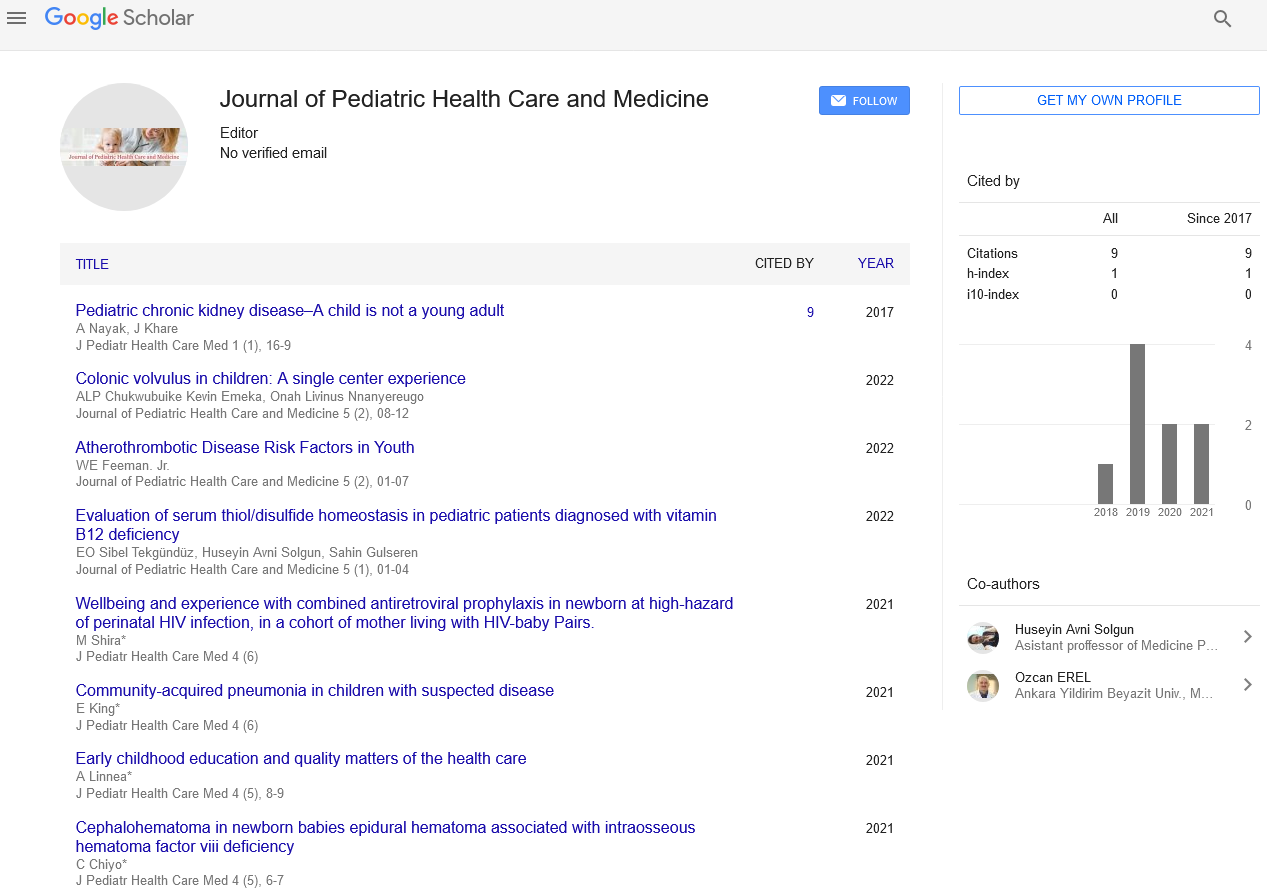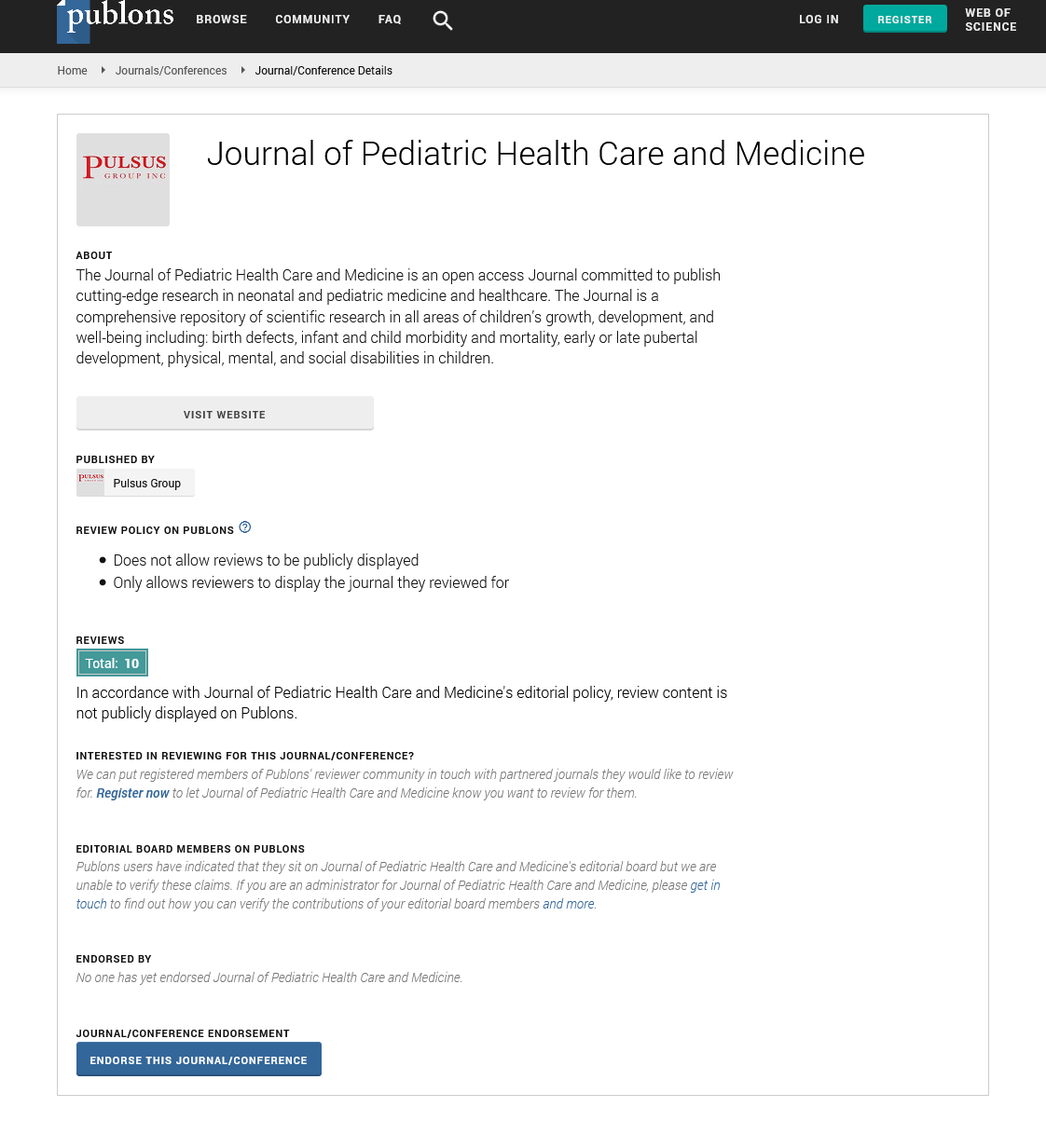Early childhood education and quality matters of the health care
Received: 06-Sep-2021 Accepted Date: Sep 20, 2021; Published: 27-Sep-2021
Citation: Linnea A. Early childhood education and quality matters of the health care. J Pediatr Health Care Med. 2021;4(5):7-8.
This open-access article is distributed under the terms of the Creative Commons Attribution Non-Commercial License (CC BY-NC) (http://creativecommons.org/licenses/by-nc/4.0/), which permits reuse, distribution and reproduction of the article, provided that the original work is properly cited and the reuse is restricted to noncommercial purposes. For commercial reuse, contact reprints@pulsus.com
Abstract
Gall The historical backdrop of Health care and instruction alludes to the improvement of care and training of youngsters from birth through eight years of age since the beginning. ECCE has a worldwide extension, and really focusing on and instructing small kids has consistently been a fundamental piece of human social orders. Plans for satisfying these cultural jobs have developed after some time and stay changed across societies, regularly reflecting family and local area structures just as the social and monetary jobs of ladies and men. All things considered, such plans have to a great extent been casual, including family, family and local area individuals.
INTRODUCTION
The While the initial two years of a kid’s life are spent in the production of a youngster’s first “ability to be self-aware”, most kids can separate among themselves as well as other people by their subsequent year. This separation is vital to the youngster’s capacity to decide how they should work corresponding to others. Guardians can be viewed as a youngster’s first educator and accordingly a vital piece of the early learning measure. Youth connection measures—those that happen from birth to age 2 can be persuasive to future schooling. With legitimate direction and investigation, youngsters start to turn out to be more alright with their current circumstance in the event that they have consistent connections to direct them. Guardians who are reliable with reaction times and feelings will appropriately make this connection almost immediately. In the event that this connection isn’t made, there can be impeding impacts on the youngster in their future connections and freedom. There are appropriate strategies that guardians and parental figures can use to set up these connections, which will thusly permit youngsters to be more open to investigating their current circumstance. Training for youthful understudies can assist them with dominating scholastically and socially. With openness and coordinated illustration plans, youngsters can learn anything they need to. The devices they figure out how to use during these starting years will give long lasting advantages to their prosperity. Formatively, having design and opportunity, youngsters can arrive at their maximum capacity [1].
Child development
Early schooling frequently centers around learning through play, in light of the exploration and reasoning of Jean Piaget, which sets that play meets the physical, scholarly, language, passionate, and social necessities (PILES) of youngsters. Kids’ interest and creative mind normally summon realizing when liberated. Learning through play will permit a kid to grow intellectually. This is the most punctual type of joint effort among kids. In this, kids learn through their associations with others. In this way, kids learn all the more proficiently and acquire information through exercises like sensational play, workmanship, and social games. Permitting kids to learn through play is basic to youth advancement permitting them to foster language abilities, work on friendly abilities, harden enthusiastic guideline, and increment their intellectual abilities in anticipation of their future forthcoming scholarly difficulties. The chance for unstructured free play is generally significant in youth training settings because of the accessibility of friends for close companions and approaching educator arranged conditions wealthy in exploratory materials [2].
Theories of child development
The Developmental Interaction Approach depends on the hypotheses of Jean Piaget, Erik Erikson, John Dewey, and Lucy Sprague Mitchell. The methodology centers around learning through disclosure. Jean Jacques Rousseau suggested that educators should take advantage of individual youngsters’ inclinations to ensure every kid gets the data generally fundamental for his own and individual turn of events. The five formative spaces of youth improvement include: To meet those formative areas, a kid has a bunch of necessities that should be met for learning. Physical: the manner by which a kid creates organic and actual capacities, including vision and engine abilities Social: the manner by which a youngster cooperates with others Children foster a comprehension of their obligations and rights as individuals from families and networks, just as a capacity to identify with and work with others. Enthusiastic: the manner by which a youngster makes passionate associations and creates self-assurance. Enthusiastic associations foster when youngsters identify with others and offer sentiments [3].
Language: the manner by which a kid conveys, including how they present their sentiments and feelings, both to others and to themselves. At 90 days, kids utilize various sobs for various requirements. At a half year they can perceive and mirror the fundamental hints of communicated in language. In the initial 3 years, kids should be presented to correspondence with others to get language. “Ordinary” language improvement is estimated by the pace of jargon procurement.
Early learning and childcare practitioner
Guaranteeing these constructive outcomes of guardians on kids are regularly given through instruction what’s more, support programs that reinforce the nature of the home climate and collaborations among guardians and their kids. As noted before, the National Education Goals Panel prescribed preparing and backing to empower guardians to invest energy every day helping their kids to learn. Many projects center on parent training and underline early, thorough pre-birth care. Youth programs that work straightforwardly with kids and incorporate methodical arrangements for creating and supporting strong associations with guardians have delivered constructive outcomes on a scope of parent results. Moreover, parent inclusion is related with positive kid results [4].
Conclusion
Further, the Initiative suggests that 10% of public early consideration furthermore, training reserves be put resources into foundation and quality improvements for ahead of schedule youth programs, and that states and territories structure extremely durable sheets accused of obligation regarding the foundation and administration of early consideration and training A very much figured plan for moving the youth program insight toward the bearing of positive results exists. The greatest test is marshaling the assets and understanding a wide based political will to accomplish better fates for our kids.
REFERENCES
- Parkins DN. Creativity by Design. Educ Leadersh. 1984;42:18-25.
- McDevitt, TM, Ormrod JE. Cognitive Development: Piaget and Vygotsky. Child Dev Educ. 2016;196–235.
- Jean Piaget. Champion of children’s ideas. Scholastic Early Childhood Today. 2001;15: 43.
- Kamii; Ewing. Basing teaching on Piaget’s constructivism. Child Educ.1996;72: 260.






